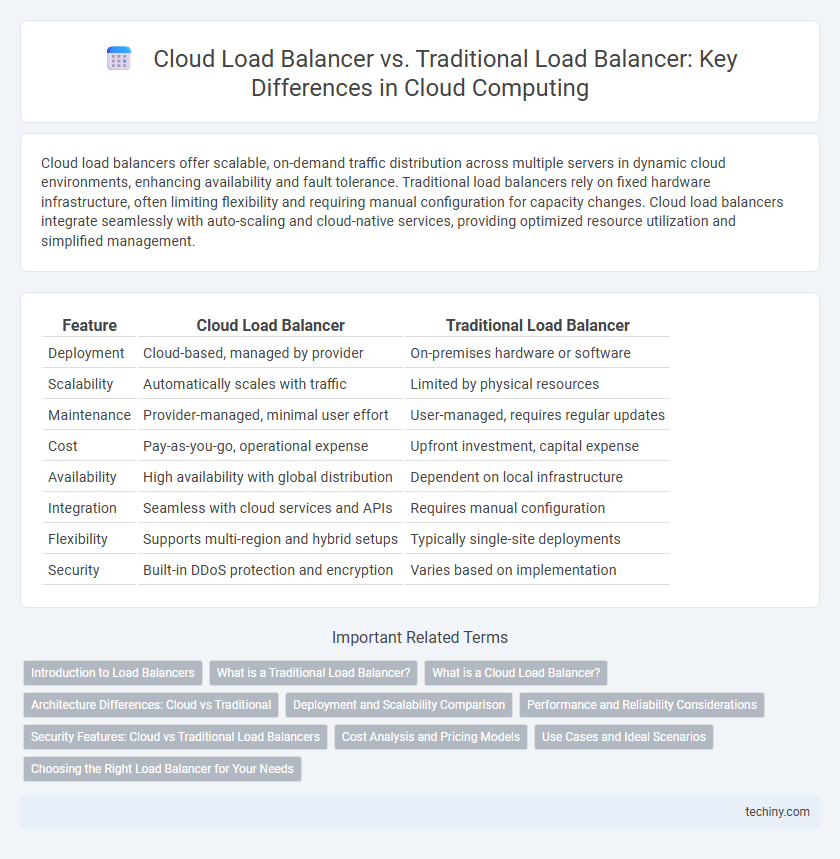Cloud load balancers offer scalable, on-demand traffic distribution across multiple servers in dynamic cloud environments, enhancing availability and fault tolerance. Traditional load balancers rely on fixed hardware infrastructure, often limiting flexibility and requiring manual configuration for capacity changes. Cloud load balancers integrate seamlessly with auto-scaling and cloud-native services, providing optimized resource utilization and simplified management.
Table of Comparison
| Feature | Cloud Load Balancer | Traditional Load Balancer |
|---|---|---|
| Deployment | Cloud-based, managed by provider | On-premises hardware or software |
| Scalability | Automatically scales with traffic | Limited by physical resources |
| Maintenance | Provider-managed, minimal user effort | User-managed, requires regular updates |
| Cost | Pay-as-you-go, operational expense | Upfront investment, capital expense |
| Availability | High availability with global distribution | Dependent on local infrastructure |
| Integration | Seamless with cloud services and APIs | Requires manual configuration |
| Flexibility | Supports multi-region and hybrid setups | Typically single-site deployments |
| Security | Built-in DDoS protection and encryption | Varies based on implementation |
Introduction to Load Balancers
Load balancers distribute network or application traffic across multiple servers to ensure reliability and scalability. Traditional load balancers are typically hardware-based appliances deployed on-premises, while cloud load balancers operate as software-defined services within cloud platforms, offering dynamic scalability and flexible configuration. Cloud load balancers integrate seamlessly with cloud infrastructure, providing automated failover, optimized resource utilization, and simplified management compared to traditional counterparts.
What is a Traditional Load Balancer?
A traditional load balancer distributes network or application traffic across multiple servers to ensure reliability and performance in on-premises environments. It typically requires manual configuration, hardware maintenance, and offers limited scalability compared to cloud-based solutions. These load balancers operate at Layer 4 (transport) or Layer 7 (application) of the OSI model to optimize resource utilization and prevent server overload.
What is a Cloud Load Balancer?
A Cloud Load Balancer efficiently distributes incoming network traffic across multiple virtual servers in cloud environments, ensuring high availability and scalability. Unlike traditional load balancers that rely on hardware appliances, cloud load balancers use software-defined architecture that dynamically adjusts to workload demands without manual intervention. They provide seamless integration with cloud services, offer automated health checks, and support global traffic distribution to optimize resource utilization and minimize latency.
Architecture Differences: Cloud vs Traditional
Cloud load balancers leverage distributed architecture across multiple data centers, enabling high availability and scalability by dynamically allocating resources based on real-time demand. Traditional load balancers rely on dedicated hardware appliances within a fixed network environment, which limits flexibility and scalability. Cloud architecture supports automated provisioning, multi-region deployments, and seamless integration with cloud-native services, contrasting with the static, manually managed setups of traditional load balancers.
Deployment and Scalability Comparison
Cloud load balancers offer rapid deployment through automated provisioning in cloud environments, eliminating the need for physical hardware setup required by traditional load balancers. Scalability is inherently dynamic in cloud load balancers, enabling automatic adjustment to traffic demands without manual intervention, whereas traditional load balancers rely on fixed capacity and require manual scaling. This makes cloud load balancers more efficient and cost-effective for fluctuating workloads compared to their traditional counterparts.
Performance and Reliability Considerations
Cloud load balancers leverage global distribution and auto-scaling capabilities to enhance performance by dynamically routing traffic based on real-time server health and load metrics, ensuring minimal latency and high throughput. Traditional load balancers rely on fixed hardware or on-premises configurations, which may introduce bottlenecks under high traffic volumes and require manual scaling efforts, potentially impacting reliability. Cloud solutions offer inherent redundancy and fault tolerance through multi-region deployment, significantly improving uptime compared to single-point failures common in traditional setups.
Security Features: Cloud vs Traditional Load Balancers
Cloud load balancers offer advanced security features such as integrated DDoS protection, automated SSL/TLS certificate management, and real-time traffic analytics that enhance threat detection and response. Traditional load balancers typically require manual configuration for security updates and lack native support for modern encryption standards, increasing vulnerability. The dynamic scalability of cloud load balancers ensures continuous application availability even under attack, unlike traditional systems constrained by physical hardware limits.
Cost Analysis and Pricing Models
Cloud Load Balancers offer flexible, pay-as-you-go pricing models that scale with usage, reducing upfront capital expenditures compared to Traditional Load Balancers, which often require fixed licensing fees and hardware investments. Operational costs for Cloud Load Balancers typically include data transfer and per-request charges, enabling more granular cost control based on actual traffic patterns. Traditional Load Balancers incur higher maintenance costs due to physical infrastructure and capacity limitations, making Cloud Load Balancers more cost-effective for dynamic workloads and fluctuating demand.
Use Cases and Ideal Scenarios
Cloud load balancers are ideal for dynamic, scalable environments such as web applications, microservices, and global content delivery, offering automatic scaling, seamless integration with cloud services, and high availability across multiple regions. Traditional load balancers suit on-premises data centers or legacy applications requiring static configurations, predictable traffic patterns, and direct control over hardware. Use cases favor cloud load balancers when handling fluctuating workloads, disaster recovery, and multi-cloud deployments, while traditional load balancers excel in isolated, security-sensitive, or compliance-driven environments.
Choosing the Right Load Balancer for Your Needs
Cloud load balancers offer dynamic scalability and seamless integration with cloud-native applications, making them ideal for handling variable traffic in distributed environments. Traditional load balancers provide robust hardware-based performance and are often preferred for on-premises infrastructures requiring high control and predictable workloads. Selecting the right load balancer depends on factors like infrastructure deployment, traffic variability, and the need for automation and scalability in modern cloud ecosystems.
Cloud Load Balancer vs Traditional Load Balancer Infographic

 techiny.com
techiny.com